Transforming Java ode to Java Using Amazon Q Transformation
In recent years, Java has seen significant advancements, with each new version introducing powerful features and optimizations. If you're still running on Java 8, you're missing out on substantial improvements in performance, syntax, and security. Upgrading from Java 8 to Java 17 can seem daunting, but Amazon Q’s transformation capabilities make it easier by automating some of the more tedious steps. In this post, we’ll walk through how to upgrade your Java 8 code to Java 17 using Amazon Q Transformation.
Why Upgrade to Java 17?
Java 17 is a long-term support (LTS) release, which means it will receive updates for several years. Some of the key features and improvements in Java 17 include:
- Sealed classes to improve inheritance control.
- Pattern matching for instance of checks, simplifying code.
- New garbage collection optimizations, improving performance.
- Text blocks for multi-line strings.
- Records to simplify data-carrier classes.
- Better JVM performance and security updates.
By upgrading, you can benefit from these features and future-proof your application.
Prerequisites
Before starting, ensure you have:
- Amazon Q setup – You should have access to the Amazon Q console or API.
- Java 8 source code – The codebase should be compiled and running without errors in Java 8.
Step-by-Step Guide to Transform Java 8 to Java 17
Assess Your Codebase
Before transforming the code, it’s essential to analyze your existing Java 8 code. Amazon Q provides an analysis report that helps identify potential issues or deprecated features.
Steps To Transform Code
Open Your Java8 Code in Intellij/Eclips IDE
- Select JDK 8 from Structure
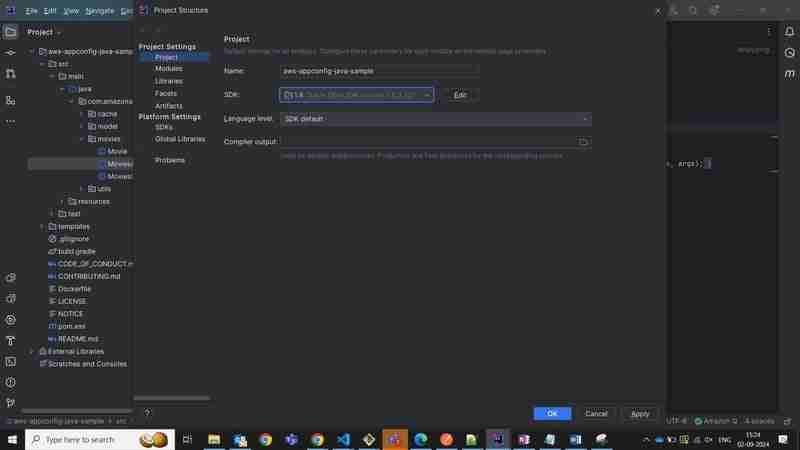
- Check The POM & Java Version
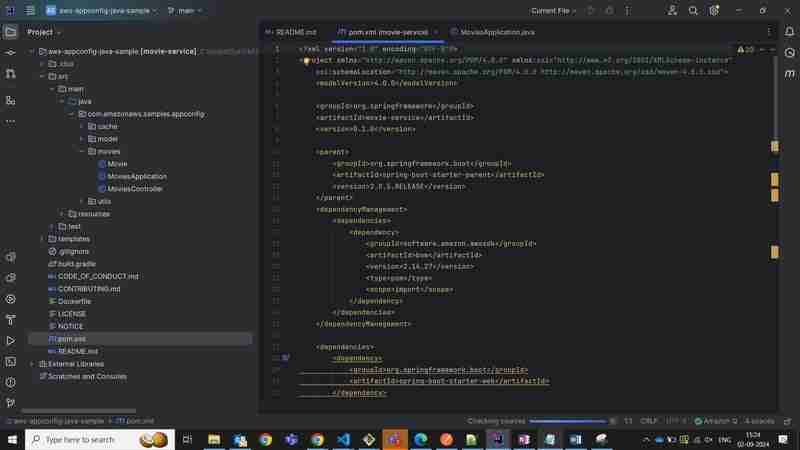

- Go to the Amazon Q Console.
Select Transformations
Amazon Q will Fetch all the project that are available to transform in current directory
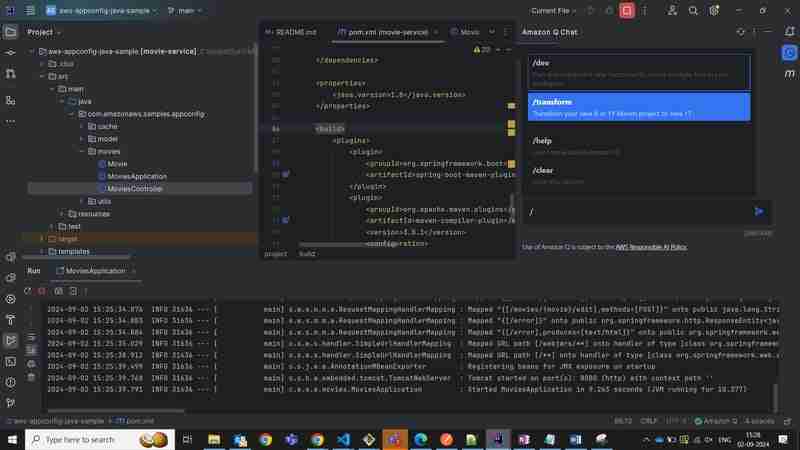

- Click On Confirm Button to start Transformation
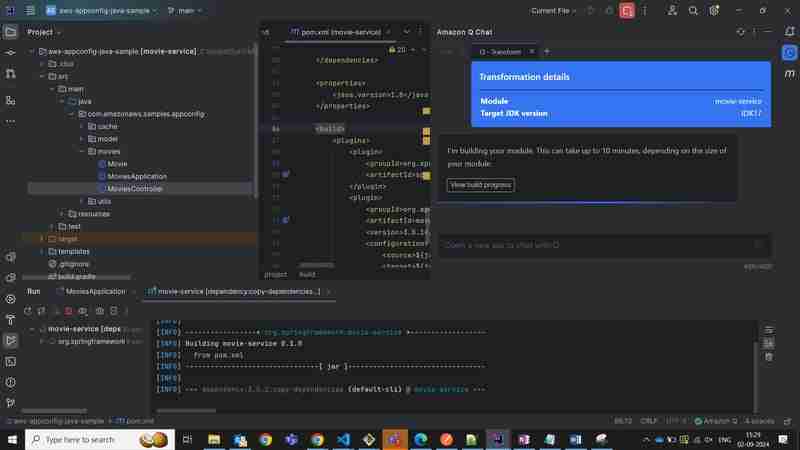
We can see the build started
We can also see the build progress by clicking on build progress button

- Amazon Q will analyze the code in secure environment
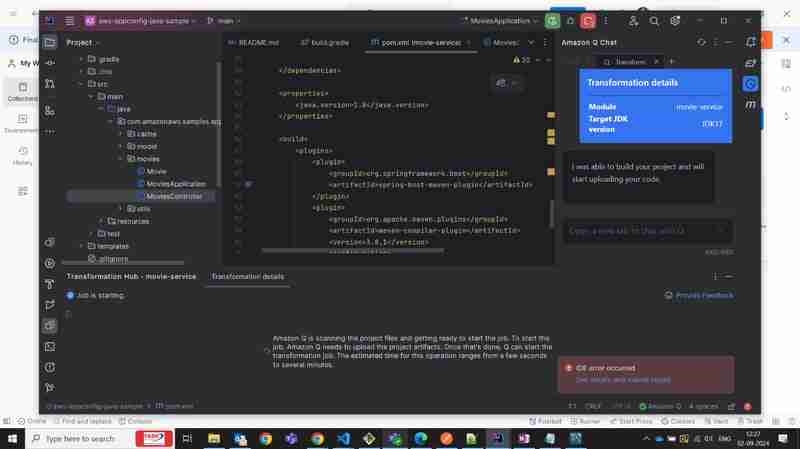
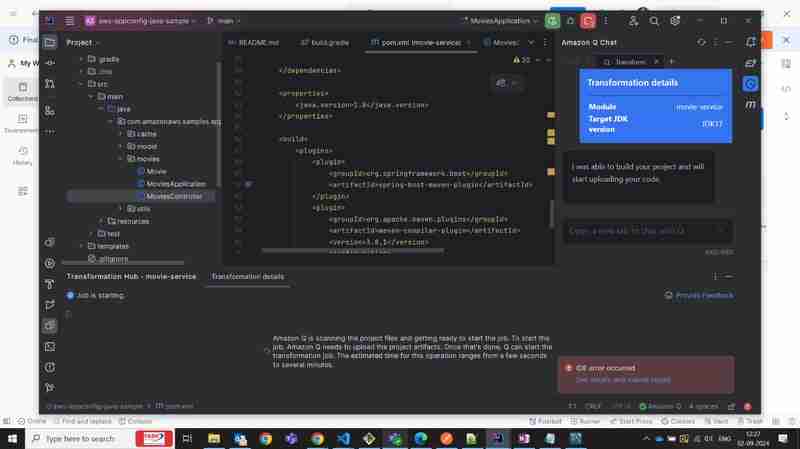
- AmazonQ is analyzing code
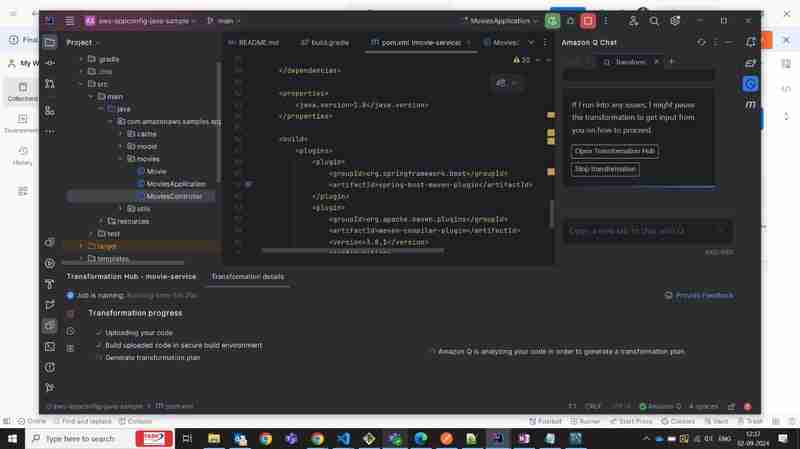
- Amazon Q Generated the transformation plan
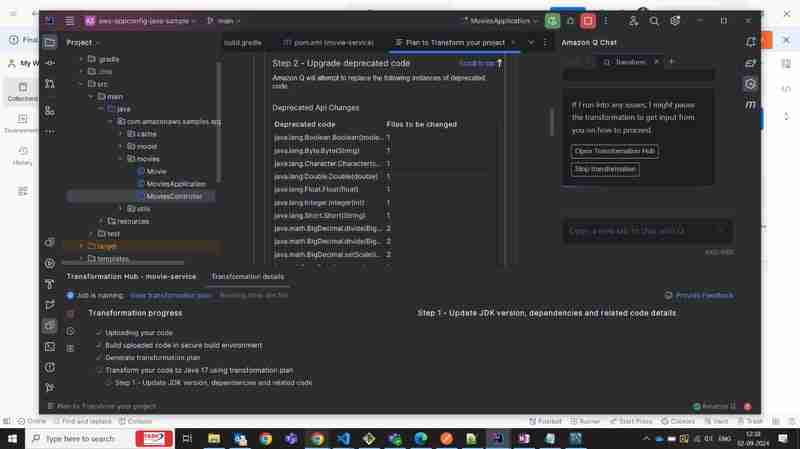
- Transformation Started

- Applying Dependency and code changes
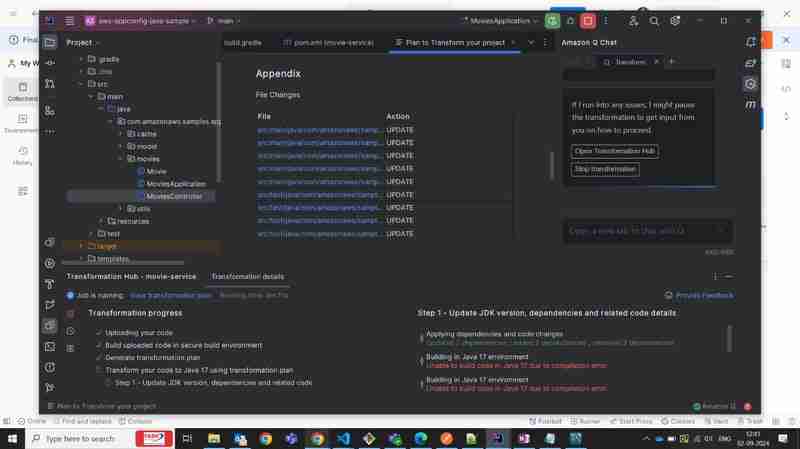
Upgrade Deprecated code
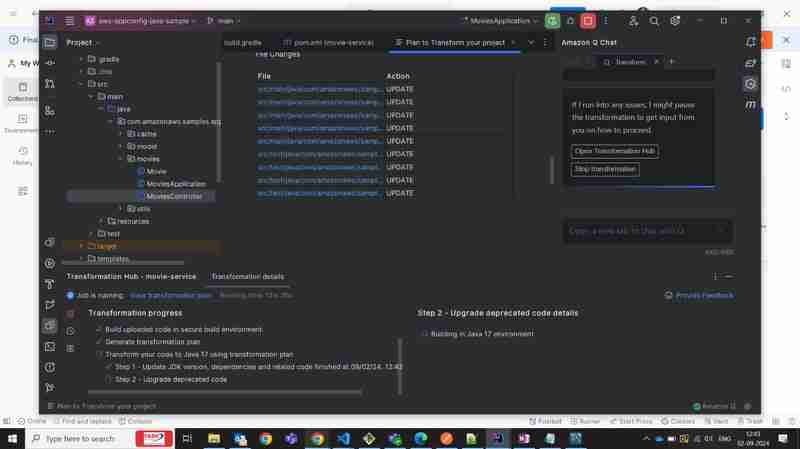
Finalize code and generating summary
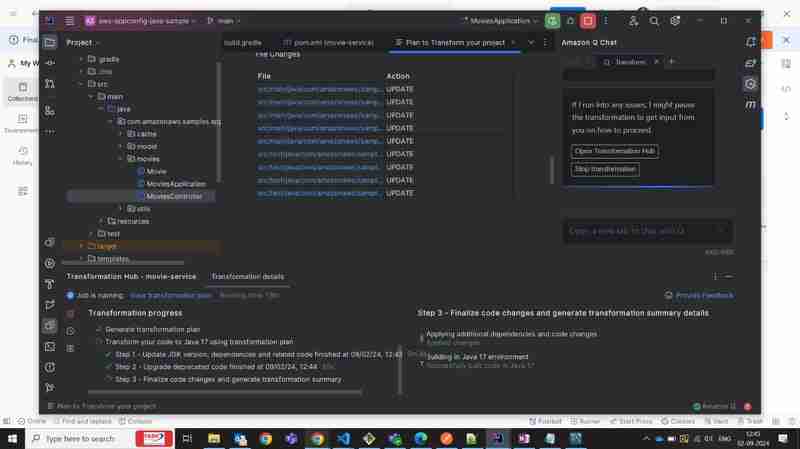
Transformation completed
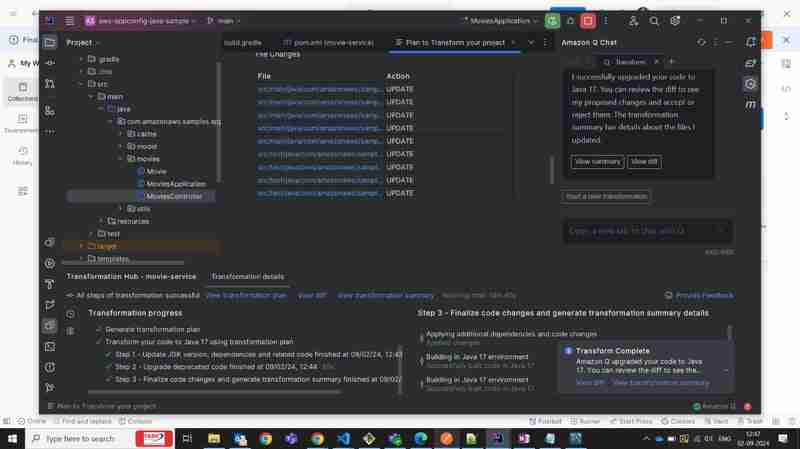
Transformation Details
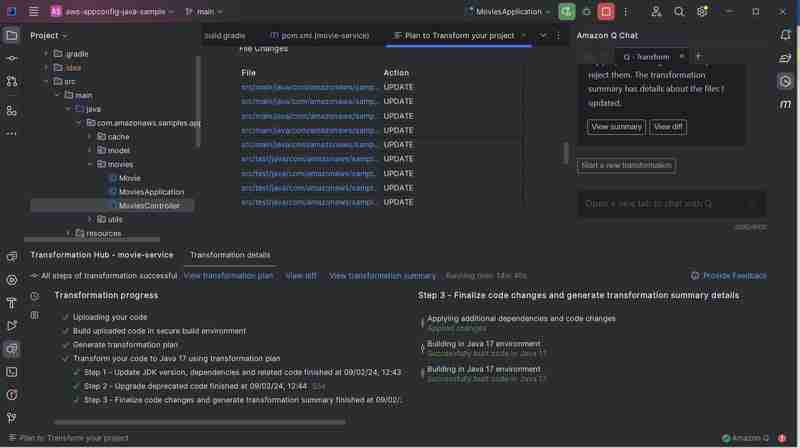
Transformation Summary on Q Dashboard

Dependency Replaced By Amazon Q

Deprecated code replaced by Q
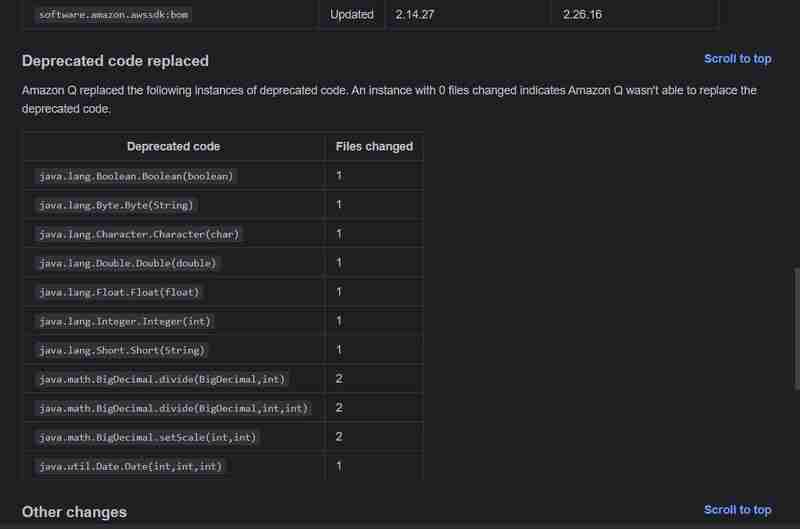
All Files Details
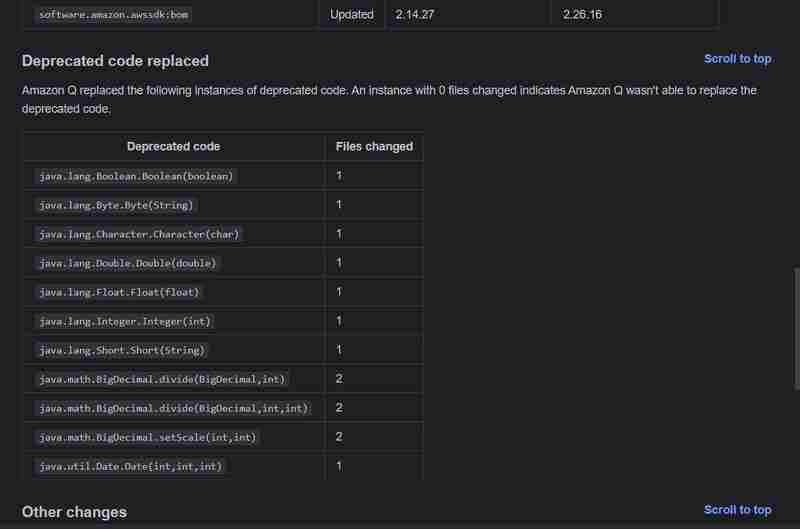
Transformation Plan
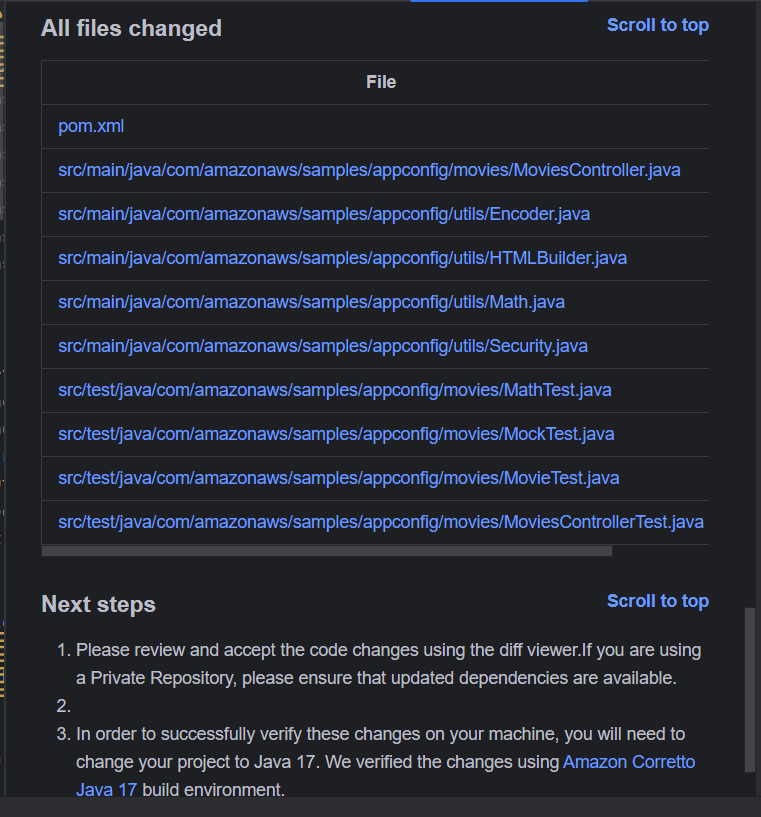
Finalize code summary

View Difference Dashboard
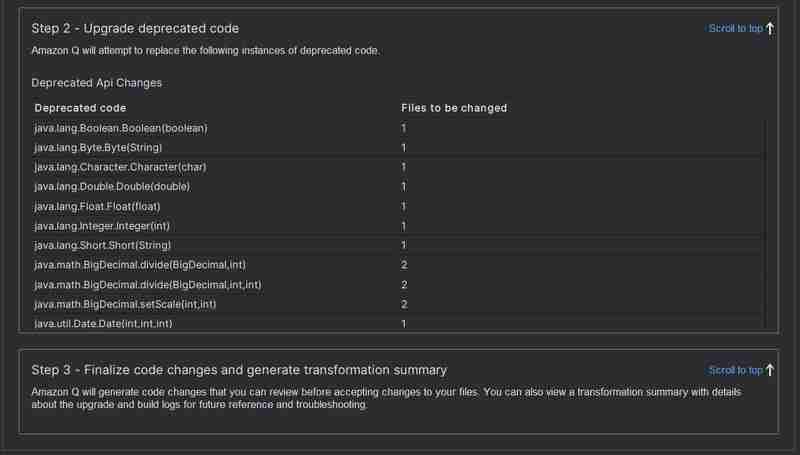
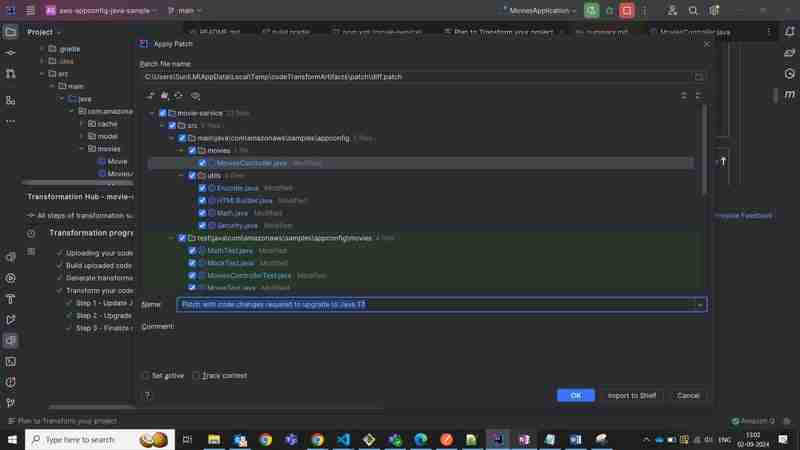
Applying the patches
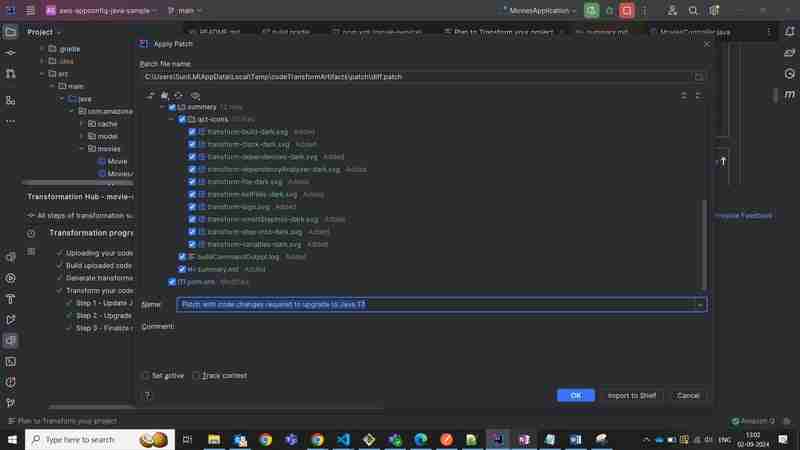
Updated POM File
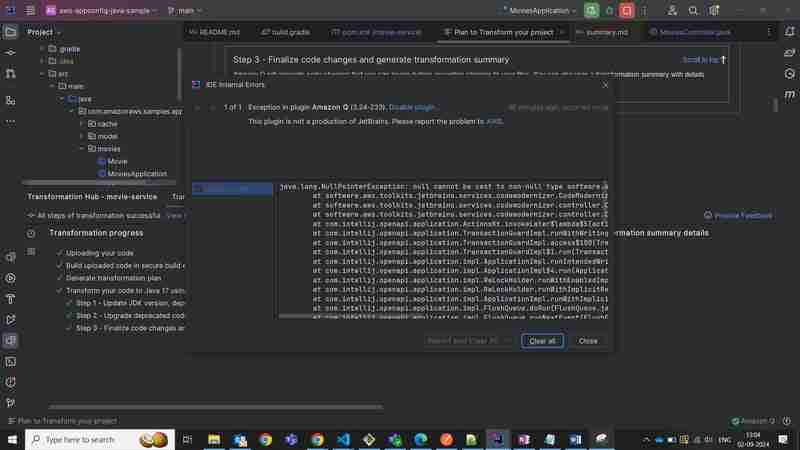
Updated JDK
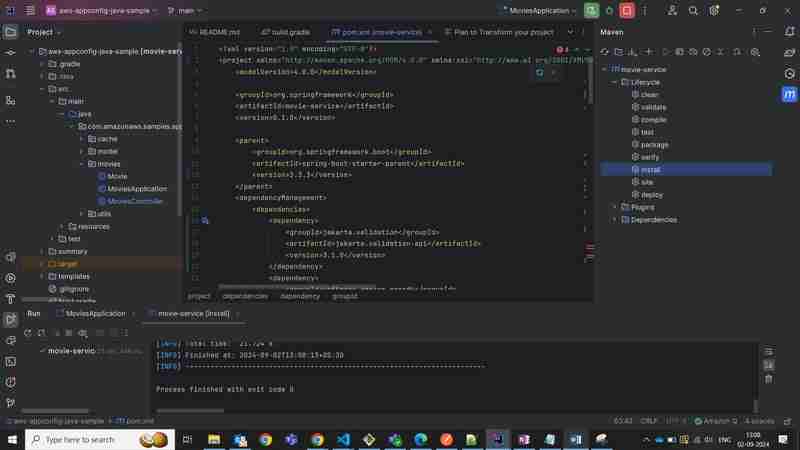
Run & Test Application
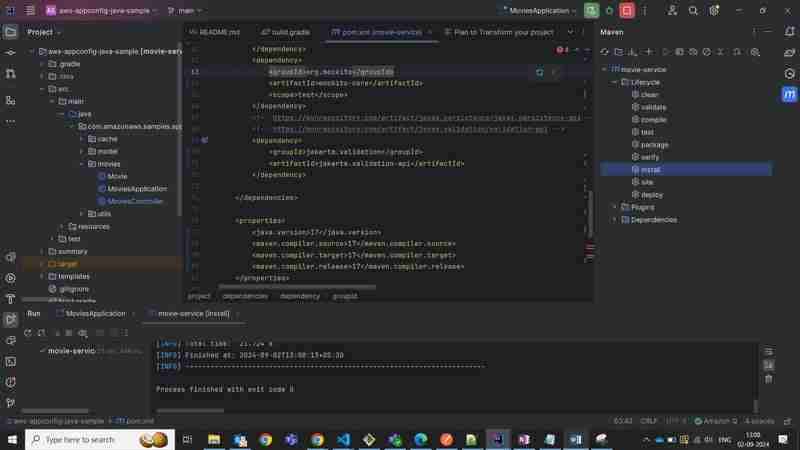
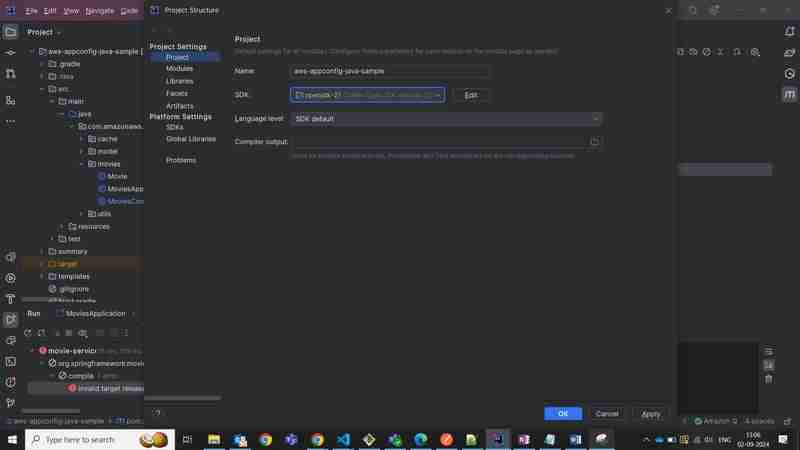
Test the Transformed Code
Once Amazon Q completes the transformation, it’s crucial to run tests to ensure everything works as expected. Run your unit tests and integration tests to confirm there are no breaking changes
- Application Running Successfully
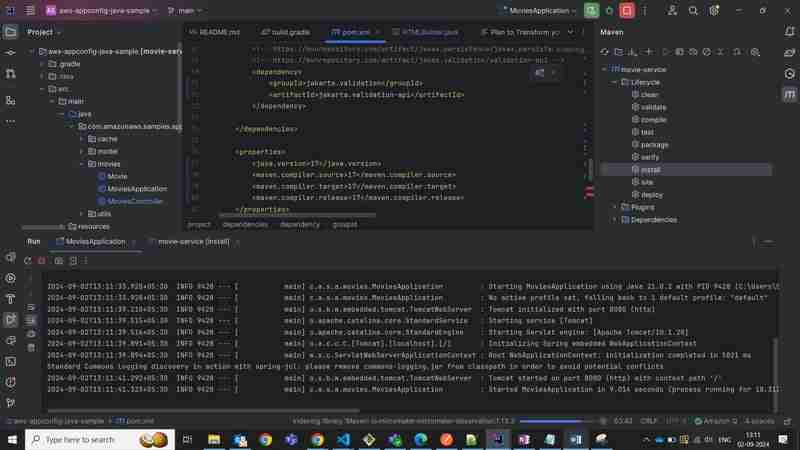
Pay close attention to:
- Removed APIs that are no longer available in Java 17.
- Changes in libraries.
- Deprecated syntax that will not be supported in Java 17.
If you have a CI/CD pipeline in place:
- Deploy the transformed code into a staging environment.
- Execute your automated test suite.
- Check for any errors or edge cases that weren’t captured during the transformation.
Manual Refinements
While Amazon Q can handle much of the code transformation, there may be some sections of code that require manual intervention. Review the following:
- Reflection-based code might need adjustments for newer Java versions.
- Third-party library compatibility – Ensure that any external libraries are compatible with Java 17.
- Custom JVM settings – Java 17 may require updated JVM settings for optimal performance.
Deploy the Upgraded Application
Once the testing is successful and any manual refinements are complete, you’re ready to deploy your updated Java 17 application.
- Update your build tools (Maven/Gradle) to use Java 17.
- Deploy the new code version to your production environment.
- Monitor the application closely for any runtime issues or performance improvements.
Conclusion
Upgrading from Java 8 to Java 17 offers substantial benefits, but the process can be time-consuming without the right tools. By using Amazon Q, you can automate many of the steps, from analyzing code to generating new Java 17-compliant snippets. Follow this guide to streamline your migration and take full advantage of the latest Java features, resulting in more efficient, secure, and maintainable code.
Happy coding!
This guide provides an overview of how you can efficiently migrate Java 8 code to Java 17 using Amazon Q transformation tools. If you have any questions or need further assistance, feel free to reach out!
-
 Unlocking JavaScript&#s Hidden Gems: Underutilized Features to Boost Code Quality and PerformanceIn the ever-evolving landscape of web development, JavaScript remains a cornerstone technology powering countless large-scale web applications. While...Programming Published on 2024-11-07
Unlocking JavaScript&#s Hidden Gems: Underutilized Features to Boost Code Quality and PerformanceIn the ever-evolving landscape of web development, JavaScript remains a cornerstone technology powering countless large-scale web applications. While...Programming Published on 2024-11-07 -
 Why Does Modifying a `const` Variable Through a Non-Const Pointer Seem to Work, but Doesn\'t Actually Change Its Value?Modifying a const Through a Non-Const PointerIn C , a const variable cannot be modified once initialized. However, in certain scenarios, it may appea...Programming Published on 2024-11-07
Why Does Modifying a `const` Variable Through a Non-Const Pointer Seem to Work, but Doesn\'t Actually Change Its Value?Modifying a const Through a Non-Const PointerIn C , a const variable cannot be modified once initialized. However, in certain scenarios, it may appea...Programming Published on 2024-11-07 -
 Android - Error uploading .aab file to play storeIf you encounter this error, follow these steps to ensure consistency with your package name and signing key: Make sure the package name in your app....Programming Published on 2024-11-07
Android - Error uploading .aab file to play storeIf you encounter this error, follow these steps to ensure consistency with your package name and signing key: Make sure the package name in your app....Programming Published on 2024-11-07 -
 How To Convert HTML To PDF With PHP(Guide For Windows. Not Mac or Linux) (Image Source) There's more than one way to convert HTML to a PDF in PHP. You can use Dompdf or Mpdf; howeve...Programming Published on 2024-11-07
How To Convert HTML To PDF With PHP(Guide For Windows. Not Mac or Linux) (Image Source) There's more than one way to convert HTML to a PDF in PHP. You can use Dompdf or Mpdf; howeve...Programming Published on 2024-11-07 -
 Will C++ Ever Embrace Garbage Collection?Garbage Collection in C : A Question of Implementation and ConsensusWhile it has been suggested that C will eventually incorporate a garbage collec...Programming Published on 2024-11-07
Will C++ Ever Embrace Garbage Collection?Garbage Collection in C : A Question of Implementation and ConsensusWhile it has been suggested that C will eventually incorporate a garbage collec...Programming Published on 2024-11-07 -
 How can I conditionally drop a column in MySQL?Conditional Column Dropping with MySQL ALTERThe ALTER command in MySQL provides a straightforward way to drop columns from tables. However, its conven...Programming Published on 2024-11-07
How can I conditionally drop a column in MySQL?Conditional Column Dropping with MySQL ALTERThe ALTER command in MySQL provides a straightforward way to drop columns from tables. However, its conven...Programming Published on 2024-11-07 -
 odern CSS Styles You Should Know In 4TL;DR: This blog uses code examples to explore five of the best CSS styles and features for web development: container queries, subgrid, pseudo-classe...Programming Published on 2024-11-07
odern CSS Styles You Should Know In 4TL;DR: This blog uses code examples to explore five of the best CSS styles and features for web development: container queries, subgrid, pseudo-classe...Programming Published on 2024-11-07 -
 When Do Arrow Functions or the Parent Scope Define the Arguments of a Function?Arguments in ES6 Arrow Functions: Official ClarificationIn ES6 arrow functions, the behavior of the arguments keyword has been a topic of debate. Some...Programming Published on 2024-11-07
When Do Arrow Functions or the Parent Scope Define the Arguments of a Function?Arguments in ES6 Arrow Functions: Official ClarificationIn ES6 arrow functions, the behavior of the arguments keyword has been a topic of debate. Some...Programming Published on 2024-11-07 -
 Here are a few potential article titles in a question format, based on your provided content: * LOAD DATA LOCAL INFILE Access Denied: How to Troubleshoot and Fix the Error? * Why Does LOAD DATA LOCALOAD DATA LOCAL INFILE Access Denied with Error: The Used Command Not PermittedWhen executing a PHP script utilizing MySQL's LOAD DATA INFILE, it ...Programming Published on 2024-11-07
Here are a few potential article titles in a question format, based on your provided content: * LOAD DATA LOCAL INFILE Access Denied: How to Troubleshoot and Fix the Error? * Why Does LOAD DATA LOCALOAD DATA LOCAL INFILE Access Denied with Error: The Used Command Not PermittedWhen executing a PHP script utilizing MySQL's LOAD DATA INFILE, it ...Programming Published on 2024-11-07 -
 How to Check if a Text File is Empty in Python?Determining the Emptiness of a Text FileIn the realm of programming, it is often necessary to ascertain whether a particular file contains any data or...Programming Published on 2024-11-07
How to Check if a Text File is Empty in Python?Determining the Emptiness of a Text FileIn the realm of programming, it is often necessary to ascertain whether a particular file contains any data or...Programming Published on 2024-11-07 -
 What is the Best Way to Store IPv6 Addresses in MySQL?Storing IPv6 Addresses in MySQL: DECIMAL(39,0) vs. VARBINARY(16)When faced with the challenge of storing IPv6 addresses in MySQL, developers often con...Programming Published on 2024-11-07
What is the Best Way to Store IPv6 Addresses in MySQL?Storing IPv6 Addresses in MySQL: DECIMAL(39,0) vs. VARBINARY(16)When faced with the challenge of storing IPv6 addresses in MySQL, developers often con...Programming Published on 2024-11-07 -
 Is ES6 Classes Syntactic Sugar for the Prototypal Pattern in JavaScript?Are ES6 classes just syntactic sugar for the prototypal pattern in Javascript?No, ES6 classes are not just syntactic sugar for the prototypal pattern....Programming Published on 2024-11-07
Is ES6 Classes Syntactic Sugar for the Prototypal Pattern in JavaScript?Are ES6 classes just syntactic sugar for the prototypal pattern in Javascript?No, ES6 classes are not just syntactic sugar for the prototypal pattern....Programming Published on 2024-11-07 -
 Day f the #daysofMiva Challenge.Day 1 of the 100 Days Challenge Date: 8/21/2024 Objective: To learn and understand variables, logical operations, and data types in JavaScript, solve ...Programming Published on 2024-11-07
Day f the #daysofMiva Challenge.Day 1 of the 100 Days Challenge Date: 8/21/2024 Objective: To learn and understand variables, logical operations, and data types in JavaScript, solve ...Programming Published on 2024-11-07 -
 How to Safely Integrate PHP-Generated Values into JavaScript Code?Incorporating PHP-Generated Values into JavaScript on a PageWhen attempting to embed a PHP-generated value into JavaScript code, you might encounter e...Programming Published on 2024-11-07
How to Safely Integrate PHP-Generated Values into JavaScript Code?Incorporating PHP-Generated Values into JavaScript on a PageWhen attempting to embed a PHP-generated value into JavaScript code, you might encounter e...Programming Published on 2024-11-07 -
 Understanding Async JavaScriptJavaScript is a single-threaded language, meaning it can only do one thing at a time. However, web applications often need to perform tasks like fetch...Programming Published on 2024-11-07
Understanding Async JavaScriptJavaScript is a single-threaded language, meaning it can only do one thing at a time. However, web applications often need to perform tasks like fetch...Programming Published on 2024-11-07
Study Chinese
- 1 How do you say "walk" in Chinese? 走路 Chinese pronunciation, 走路 Chinese learning
- 2 How do you say "take a plane" in Chinese? 坐飞机 Chinese pronunciation, 坐飞机 Chinese learning
- 3 How do you say "take a train" in Chinese? 坐火车 Chinese pronunciation, 坐火车 Chinese learning
- 4 How do you say "take a bus" in Chinese? 坐车 Chinese pronunciation, 坐车 Chinese learning
- 5 How to say drive in Chinese? 开车 Chinese pronunciation, 开车 Chinese learning
- 6 How do you say swimming in Chinese? 游泳 Chinese pronunciation, 游泳 Chinese learning
- 7 How do you say ride a bicycle in Chinese? 骑自行车 Chinese pronunciation, 骑自行车 Chinese learning
- 8 How do you say hello in Chinese? 你好Chinese pronunciation, 你好Chinese learning
- 9 How do you say thank you in Chinese? 谢谢Chinese pronunciation, 谢谢Chinese learning
- 10 How to say goodbye in Chinese? 再见Chinese pronunciation, 再见Chinese learning

























